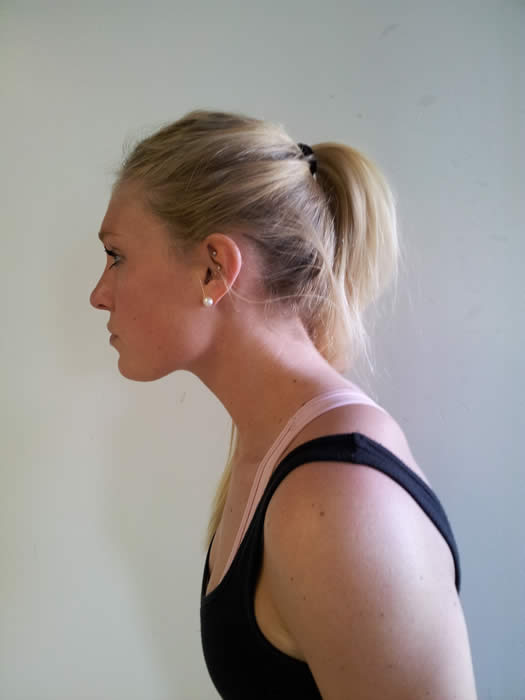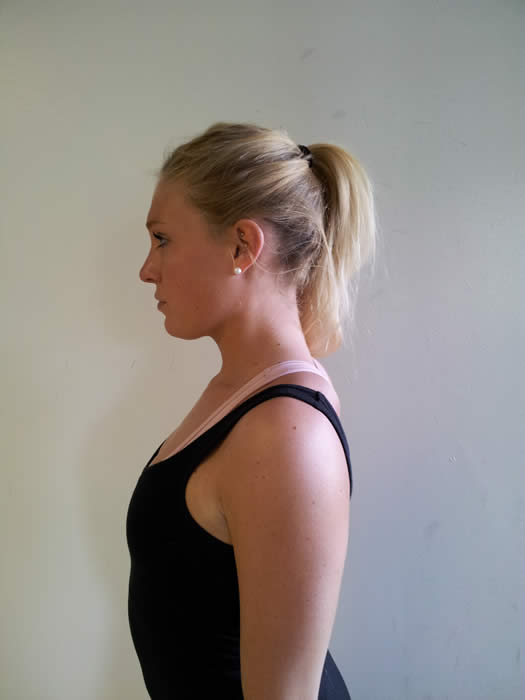April 2014
Forward Head Posture (FHP)-The Increasing Risk to Upper Back-Neck Health
by Nick A. Titley, M.S., NPI-Certified Posture Specialist
Musculoskeletal conditions can result in minor aches and pains or long term pain, discomfort, and sometimes loss of function. Now that I have your attention, as you lean forward on the edge of your seat to continue reading this information, your shoulders may be rounding forward while your head might be shifting slightly outward. If you consistently read in this posture, or if you find yourself hanging your head when you walk and send a text message, you might be more in line for developing a common musculoskeletal condition called forward head posture.
According to Spine Health, forward head posture (FHP) is a musculoskeletal condition where your cervical spine, or head and neck area, have protracted forward away from your body's line of gravity. Forward head posture can also cause a hunched forward appearance and will affect your head and spinal posture, stance, and gait while you're in motion.
An article by the Nikitow Chiropractic Wellness Center explains how you could develop FHP due to trauma and bad posture while repeatedly using computers, watching TV, and playing video games. Heavy backpacks and lying on improperly placed pillows can also force your head and neck to adapt to a forward head posture.
The Wellness Center also explains how FHP is developed as a result of repetitive behaviors. These behaviors strengthen your nerve and muscle pathways, causing the head and neck to adapt to FHP more readily. "It is the repetition of forward head movements combined with poor ergonomic postures and/or trauma that causes the body to adapt to forward head posture."
It's easy for you to develop FHP. In many of the activities you're currently doing, you may find yourself bending or lurching your neck forward to stare at something. Imagine the way you walk, lay, sit, or stand while reading or typing. If you're constantly glued to a device and find yourself bending or leaning your head forward, you're increasing your risk of developing FHP.
According to Dr. Rene Cailliet forward head posture can add up to thirty pounds of abnormal leverage on the cervical spine and this could pull the entire spine out of alignment. It also aids in tension headaches, tight upper back muscles, and discomfort in the neck area. Severe FHP leads to long term muscle strain, disc hernias, and pinched nerves.
Dr. Cailliet also explains that forward head posture (FHP) may result in the loss of 30% of vital lung capacity. "These breath-related effects are primarily due to the loss of the cervical lordosis which blocks the action of the hyoid muscles, especially the inferior hyoid responsible for helping lift the first rib during inhalation."
Handling FHP can be challenging and if it's severe, or if you're currently worried about symptoms, then you should schedule an appointment with a National Posture Institute-Certified Posture Specialist, healthcare professional, or register for NPI’s Online Public Posture Program for consumers to learn about posture and daily posture correction exercises (learn more here: NPI’s Online Public Posture Program.) If you have minor cases of FHP or you're worried about it developing further, then I suggest you begin by changing your habits and by developing a better awareness about your postural alignment when you engage in your daily routines.
 |
 |
| Forward Head Posture |
Forward Head Posture Corrected |
Pay special attention to the activities that you engage in repetitively (i.e. for long periods of time). If you find yourself leaning forward while staring at the computer, or hanging your head to send a text message, then you'll need to make some adjustments to your body's position and to your workspace.
Be ready to adjust your seat and your computer's position and its monitor. You may also need to shift your arms in front of you while texting to keep your head and neck in a better position. Aim for a position where you can sit or stand comfortably without putting strain on your head and neck.
The likelihood of developing FHP increases when you spend prolonged time in bad head and neck posture. What you do consistently will make the difference between good postural alignment and musculoskeletal problems. FHP must be corrected with habitual adjustments to your head and neck's postural alignment and to your body's position while you engage in your typical activities.
References:
- Morrison , G. (2011, July 03). How poor posture causes neck pain. Retrieved from spine-health.com/conditions/neck-pain/how-poor-posture-causes-neck-pain
- Nikitow, D. (2014). Damaging effects of forward head posture. Retrieved from denvertechchiro/files/fhp_revised.pdf
- Cailliet R, Gross L, Rejuvenation Strategy. New York, Doubleday and Co. 1987
- National Posture Institute Online Public Posture Program for the Public: http://www.npionline.org/programs/public/index
|
